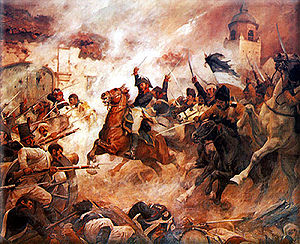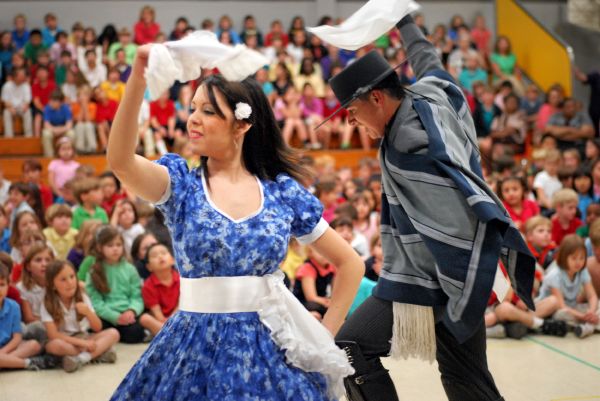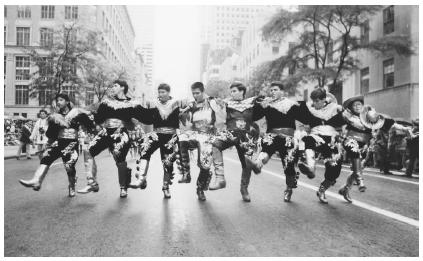
Monday, April 15, 2013
Natural Disasters
On the morning of February 27, 2010, Chile was hit with an earthquake which measured an 8.8 on the Richter scale. The death toll did not reach thousands, despite how big the earthquake was. Because of this earthquake, Chile was able to build better building codes, which has continually been upgraded. This has better prepared Chile for any upcoming earthquakes to lower the death toll.


1970
Allende was the first president in a non-communist country. He became the president of Chile in 1970. Introducing Marxist social and economic reforms, Allende rapidly established associations with Cuba and the People's Republic of China.


1817
Chile was ruled by Spain for over four hundred years. In 1817, Chile gained its independence from Spain, after 7 years of warfare.




Clothing
Traditional Chilean clothing is usually very vivid and colorful. It is also based around comfort due to the fact that many of Chileans work with jobs that use manual labor. Modern fashion also has much influence from traditional Chilean clothing because it is very patriotic, representing its country and it being bright.

The Chamanto (above) is a traditional Chilean garment, worn by both men and women at any time of day. This poncho is very colorful and attractive, and hard to make due to the complex weaving involved in making them. It is usually made of silk or wool.

The Chamanto (above) is a traditional Chilean garment, worn by both men and women at any time of day. This poncho is very colorful and attractive, and hard to make due to the complex weaving involved in making them. It is usually made of silk or wool.
Language
The original Spanish spoken in Chile was similar to the Andalusian dialect, but indigenous languages such as Quechua and Mapudungun influenced Chile as well. Final syllables and "s" sounds are likely to be dropped and said softly. Chilean Spanish is hard for foreigners to understand because it is high in slang and local expressions.
Religion
Most of the Chilean population, about 73%, is associated with the Roman Catholic Church. About 15% classify their selves with many Protestant groups, which include the Anglicans and Lutherans. A majority of Chilean Protestants, approximately 90% of them, belong to the Pentecostal Church. In Chile, about 4% of the population participate in other religions, such as Judaism, Islam, and Greek Orthodox and about 8% do not belong to any religion. Many Chileans respect the beliefs of the other religions.
Art
Chilean graphic arts consist of mainly paintings. The Museum of Fine Arts and the Museum of Contemporary Art in Santiago display Chilean painters' work ever since the nineteenth century. Rustic Chilean landscapes and portraits of regular people have been painted by nineteenth century painters like Pedro Lira and Juan Francisco Gonzalez. In the 20th century, Chile produced painters who have achieved fame outside of Chile, especially in Europe and the U.S.




Thursday, April 4, 2013
Dance
The country of Chile has two energetic, opposing cultures: the cosmopolitan culture and the popular culture of the peasants, is mainly Spanish but contains traces of Araucanian heritage. The culture of peasants is greatly influenced in their music and dance.
The refalosa originated from Peru. The dance, cuando came from Spain, while the rhythms of the peasant dance guaracha are the legacy of Colombian and Cuban dance. The corrido is typically Mexican.



The refalosa originated from Peru. The dance, cuando came from Spain, while the rhythms of the peasant dance guaracha are the legacy of Colombian and Cuban dance. The corrido is typically Mexican.



1520
Ferdinand Magellan, a Portugese explorer became the first European to see Chile, sailing through the strait that is now named after him.


Wednesday, March 20, 2013
1541
In 1541, Pedro de Valdavia crossed into the central valley, having followed the Inca road south from Peru. He founded Santiago in February, and established strongholds there soon after crossing into Mapuche domains.

1541
Diego de Almagro and his Spanish conquistadors were the first Europeans to arrive in Chile. Pedro de Valdivia founded Santiago. The new settlers had on and off wars with the indigenous Indians and constantly fought the Araucanos.
Food
The cuisine of Chilean food was influenced both by Indian and European food. The national dish of Chile, porotos granados, has Indian cooking, but Spanish modifications.


STAPLES
Many Chilean meals have a combination of meat, vegetables, and seafood, usually found in the middle of a baked or fried crust. An example of a typical Chilean dish is empanadas. It is served throughout the country. Empanadas are a fried crust shell that contain can contain beef, onion, and olive dumplings. Cazuela de ave, a rich chicken, potato and pepper stew, is a type of Chilean staple. In addition, humitas are a meal consisting of a paste with grated corn and fried oninos and cooked in cornhusks. As the hot weather comes around, the people of Chile regularly feast on ensalada chilena, which is a fresh onion and tomato salad. Chile has an abundant amount of seafood, which Chileans make paella and shrimp marinated ub Chilean salsa to make Spanish-inspired dishes.
Thursday, February 21, 2013
1000
The first settlers in Chile were mirgrating Indians, the Incas. They extended their rule to northern Chile while southern Chile was ruled by Araucanos.

Incas

Araucanos
Incas
Araucanos
Subscribe to:
Comments (Atom)